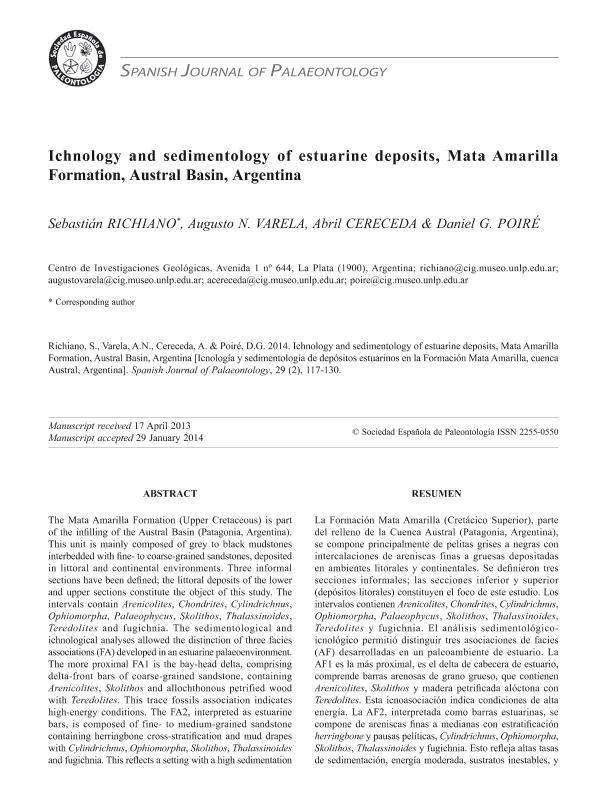Mostrar el registro sencillo del ítem
dc.contributor.author
Richiano, Sebastián Miguel

dc.contributor.author
Varela, Augusto Nicolás

dc.contributor.author
Cereceda, Abril

dc.contributor.author
Poire, Daniel Gustavo

dc.date.available
2018-01-05T18:01:49Z
dc.date.issued
2014-02
dc.identifier.citation
Richiano, Sebastián Miguel; Varela, Augusto Nicolás; Cereceda, Abril; Poire, Daniel Gustavo; Ichnology and Sedimentology of Estuarine deposits from Mata Amarilla Formation, Austral Basin, Argentina; Sociedad Española de Paleontología; Spanish Journal of Palaeontology; 29; 2; 2-2014; 117-130
dc.identifier.issn
2255-0550
dc.identifier.uri
http://hdl.handle.net/11336/32416
dc.description.abstract
The Mata Amarilla Formation is part of the infilling of the Austral Basin, located in Southern Patagonia, Argentina. This unit is mainly composed of grey to black mudstones interbedded with white fine- to coarse-grained sandstones, deposited in littoral and continental environments. The unit has been dated between the lower Cenomanian to the Santonian and has been divided into three informal sections: lower (littoral), middle (continental) and upper (littoral). The lower and upper sections constitute the main object of this study and they are interpreted as estuary, bay-head delta and coastal lagoon deposits. The intervals contain Arenicolites, Chondrites, Cylindrichnus, Ophiomorpha, Palaeophycus, Skolithos, Thalassinoides, Teredolites and fugichnia. The sedimentological and ichnological analyses allowed the interpretation of an overall estuarine palaeoenvironment, which is composed of three facies associations (FA) characterized by discrete associations of trace fossils. The more proximal FA is the bay-head delta, comprising delta-front bars of coarse-grained sandstone, containing Arenicolites, Skolithos and allochthonous petrified wood containing Teredolites. The trace fossils recorded in this FA indicate high-energy conditions. The second unit is interpreted as estuarine bars. This second FA is composed of fine- to medium-grained sandstone containing herringbone cross-stratification and mud drapes with Cylindrichnus, Ophiomorpha nodosa, Skolithos, Thalassinoides and fugichnia. This reflects a setting with a high sedimentation rates, moderate energy, unstable substrates, and normal salinity. Finally, the fine-grained estuarine deposits are characterized by heterolithic composite bedsets (e.g., flaser, wavy and lenticular bedding), locally with synaeresis cracks. Such units are bioturbated with Arenicolites, Chondrites, Cylindrichnus, Palaeophycus, Thalassinoides and Skolithos. These ichnogenera are generally characterized by their small sizes, consistent with a stressed palaeoenvironment, possibly a function of fluctuations in salinity. The distribution, size and abundance of the trace fossils were controlled by several palaeoenvironmental factors including energy, the sedimentation rate, and the fluctuations of salinity contents. This variability of palaeoenvironmental factors is directly related to the fresh water and sediment input from rivers flood, which took place during the wet seasons of a warm, temperate climate.
dc.format
application/pdf
dc.language.iso
eng
dc.publisher
Sociedad Española de Paleontología
dc.rights
info:eu-repo/semantics/openAccess
dc.rights.uri
https://creativecommons.org/licenses/by-nc-sa/2.5/ar/
dc.subject
Trace Fossils
dc.subject
Estuarine Deposits
dc.subject
Mata Amarilla Formation
dc.subject
Cretaceous
dc.subject
Austral Basin
dc.subject.classification
Meteorología y Ciencias Atmosféricas

dc.subject.classification
Ciencias de la Tierra y relacionadas con el Medio Ambiente

dc.subject.classification
CIENCIAS NATURALES Y EXACTAS

dc.title
Ichnology and Sedimentology of Estuarine deposits from Mata Amarilla Formation, Austral Basin, Argentina
dc.type
info:eu-repo/semantics/article
dc.type
info:ar-repo/semantics/artículo
dc.type
info:eu-repo/semantics/publishedVersion
dc.date.updated
2018-01-03T19:06:12Z
dc.journal.volume
29
dc.journal.number
2
dc.journal.pagination
117-130
dc.journal.pais
España

dc.journal.ciudad
Madrid
dc.description.fil
Fil: Richiano, Sebastián Miguel. Consejo Nacional de Investigaciones Científicas y Técnicas. Centro Científico Tecnológico Conicet - La Plata. Centro de Investigaciones Geológicas. Universidad Nacional de La Plata. Facultad de Ciencias Naturales y Museo. Centro de Investigaciones Geológicas; Argentina
dc.description.fil
Fil: Varela, Augusto Nicolás. Consejo Nacional de Investigaciones Científicas y Técnicas. Centro Científico Tecnológico Conicet - La Plata. Centro de Investigaciones Geológicas. Universidad Nacional de La Plata. Facultad de Ciencias Naturales y Museo. Centro de Investigaciones Geológicas; Argentina
dc.description.fil
Fil: Cereceda, Abril. Consejo Nacional de Investigaciones Científicas y Técnicas. Centro Científico Tecnológico Conicet - La Plata. Centro de Investigaciones Geológicas. Universidad Nacional de La Plata. Facultad de Ciencias Naturales y Museo. Centro de Investigaciones Geológicas; Argentina
dc.description.fil
Fil: Poire, Daniel Gustavo. Consejo Nacional de Investigaciones Científicas y Técnicas. Centro Científico Tecnológico Conicet - La Plata. Centro de Investigaciones Geológicas. Universidad Nacional de La Plata. Facultad de Ciencias Naturales y Museo. Centro de Investigaciones Geológicas; Argentina
dc.journal.title
Spanish Journal of Palaeontology
dc.relation.alternativeid
info:eu-repo/semantics/altIdentifier/url/http://www.sepaleontologia.es/revista/anteriores/REP%20%282013%29%20vol.%2029/2/01.%20Richiardo%20et%20al.pdf
dc.relation.alternativeid
info:eu-repo/semantics/altIdentifier/url/http://sepaleontologia.es/sjp-2014-vol-29-no-2/
Archivos asociados
